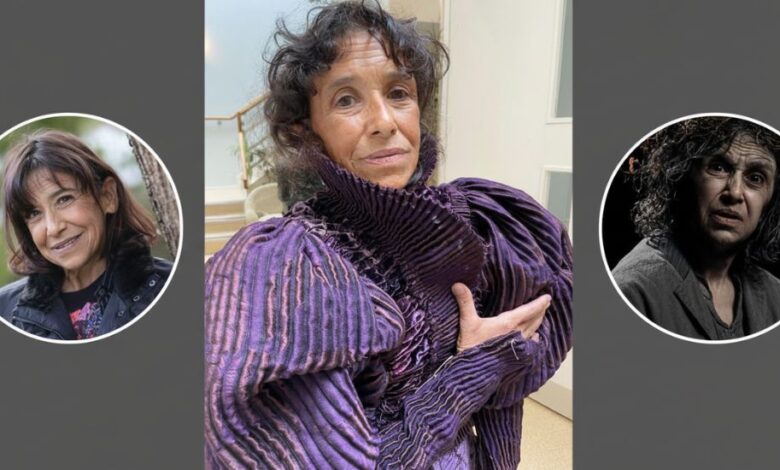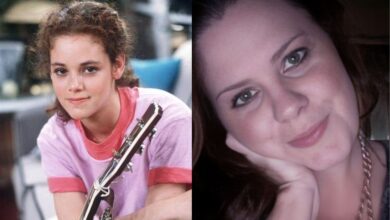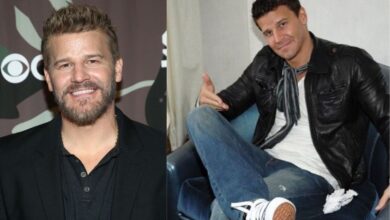Kathryn Hunter: The Shape-Shifting Genius of Stage and Screen

Few actors in contemporary theatre possess the ability to transform, transcend, and transfix quite like Kathryn Hunter. Across more than four decades, she has redefined what performance can be — bending gender, age, species, and even physical limits in ways few would dare attempt. From intimate black-box theatres to major film sets with Denzel Washington and Frances McDormand, Hunter has earned a reputation as one of Britain’s most fearless, physically inventive, and spiritually compelling performers.
This is the story of a woman who turned pain into art, who refused to be confined by category, and who continues to blur the boundaries between body and imagination.
Early Life and Transformation
Kathryn Hunter was born Aikaterini Hadjipateras on 9 April 1957 in New York City to Greek parents. Although American-born, she spent her childhood in Britain, where she would eventually forge her artistic identity. She studied at the Royal Academy of Dramatic Art (RADA), a training ground for some of Britain’s finest classical actors.
It was during her time at RADA that tragedy struck. A devastating car crash left her with multiple serious injuries — a broken back, a crushed foot, and a collapsed lung — and a permanent limp. Years later, she revealed the incident had been a suicide attempt following a deep period of despair. Instead of ending her life, however, the accident reshaped it.
The physical limitations became part of her artistry. Her walk, once a source of insecurity, became a signature. Hunter learned to move with the kind of awareness and expressiveness that would later define her performances. “It’s important to be ugly,” she once told The Guardian, meaning that truth in art lies not in prettiness but in raw, unguarded honesty.
The Emergence of a Physical Performer
Hunter’s early career aligned with the rise of physical theatre, an experimental movement that emphasized the body over language. She trained in France with the renowned clown teacher Philippe Gaulier, whose methods championed playfulness, risk, and emotional vulnerability.
This training ignited Hunter’s fascination with transformation — not just playing characters, but becoming them. Her stage presence is an alchemy of movement, voice, and shape. She contorts, shrinks, expands; she seems capable of dissolving her body into something otherworldly.
Critics have often described her as a “shape-shifter.” She can appear fragile one moment and animalistic the next. This elasticity became her trademark — and soon her passport into the upper echelons of British theatre.
Breaking Barriers: Gender, Body, and Beyond
One of Hunter’s defining traits is her refusal to accept gender as a boundary in performance. She has portrayed men, women, and beings that defy categorization altogether.
“I gravitated towards male roles because men are given more interesting things to do,” she explained in a 2021 interview. That simple but subversive statement encapsulates her career philosophy. Rather than wait for “good roles for women,” Hunter seized the best roles available — regardless of gender.
Her groundbreaking performance as King Lear made her the first British woman ever to play the role professionally. It was not a gimmick; it was revelation. Reviewers praised her portrayal as both tender and terrifying, a study in vulnerability as much as in power.
Beyond gender, Hunter also explored species. In Kafka’s Monkey, she embodied an ape performing humanity. Her transformation onstage was so complete that audiences reportedly forgot they were watching a human being. In The Bee, she oscillated between multiple characters at dizzying speed, each with distinct physical rhythm and tone.
Hunter’s ability to inhabit the in-between — the borderlands of human identity — makes her one of theatre’s most radical storytellers.
Theatre as Metamorphosis
Working with innovative companies such as Complicité, Shakespeare’s Globe, and the Royal Shakespeare Company, Hunter helped expand the language of modern theatre. Her collaboration with Complicité’s artistic director Simon McBurney and her husband, Marcello Magni (a Complicité co-founder), has been particularly influential.
Hunter’s stagecraft thrives on minimalism. A tilt of her head, a sudden shift of weight, or a deep intake of breath can transform the atmosphere of a performance. She once said she aims to “make the invisible visible” — to reveal what lies beneath the text, in the soul of the story.
Her work in The Visit by Friedrich Dürrenmatt earned her the Laurence Olivier Award for Best Actress in 1991. The recognition affirmed what theatre insiders already knew: Kathryn Hunter was a force of nature.
She followed that triumph with daring interpretations of The Tempest, A Midsummer Night’s Dream, Cyrano de Bergerac, and Oedipus Rex. Each time, she brought unexpected textures — a crack in the voice, a lurch in the gait — that exposed the fragility beneath even the most powerful characters.
The Leap to Screen
Though Hunter’s name was legendary in the theatre world, film audiences encountered her more gradually. Her first significant mainstream appearance came in Mike Leigh’s All or Nothing (2002), where she delivered a raw, deeply human supporting performance.
In 2007, she entered global pop culture as Arabella Figg in Harry Potter and the Order of the Phoenix. Fans of the series remember her as the eccentric squib who keeps watch over Harry’s neighborhood — a small role, but one stamped with Hunter’s unique oddity and warmth.
Her most celebrated screen role arrived in 2021, when she played the three witches in Joel Coen’s The Tragedy of Macbeth. Her performance astonished critics. With contorted limbs, a rasping voice, and eerie stillness, Hunter conjured three distinct presences in a single body. Vanity Fair called her “a genuinely singular performer … she only needs a moment or two to take your breath away.”
In 2022, she reached a new generation of viewers through Andor, the acclaimed Star Wars series, playing Eedy Karn, mother of the obsessive Imperial officer Syril Karn. Her scenes were domestic yet unnerving, a testament to how even the smallest roles become unforgettable in her hands.
The Philosophy Behind the Performance
What drives Kathryn Hunter? At heart, her work is about transformation — not just of character, but of perception.
She rejects the idea that acting should be naturalistic or pretty. “It’s important to be ugly,” she insists — a rejection of vanity and an embrace of truth. For Hunter, the actor’s body is not merely a vessel but a landscape. It carries pain, memory, and story.
Her limp, once an “imperfection,” is now integral to her presence. Rather than hide it, she highlights it, allowing her gait to influence rhythm and emotion. In a world obsessed with flawless beauty, Hunter’s work is a reminder that art lives in imperfection — that the cracks are where the light gets in.
She also believes in theatre as community — a space of empathy and shared risk. Her performances often blur the line between performer and audience, as if she’s inviting us not just to watch but to feel alongside her.
Critical Reception and Legacy
The word most often associated with Hunter is fearless. Critics have long marveled at her ability to occupy extremes: childlike innocence and demonic energy, vulnerability and authority, comedy and tragedy.
Michael Billington of The Guardian once wrote that Hunter “possesses a chameleonic gift that makes her seem capable of playing anything — even the weather.” It’s hard to think of a more apt description.
In The Tragedy of Macbeth, Joel Coen designed the entire visual language partly around her physicality. The stark black-and-white imagery accentuated every twitch, every rasp, every ripple of transformation. Denzel Washington reportedly called her “astonishing.”
Younger performers cite her as a model for daring. In an era when typecasting still dominates film and television, Kathryn Hunter stands as proof that an artist’s range is limited only by imagination.
Personal Life and Continuing Influence
Hunter married Marcello Magni, her frequent collaborator and co-founder of Complicité. Their partnership — artistic and personal — was built on mutual exploration and a shared belief in theatre as a living, breathing organism. Even after Magni’s passing in 2022, Hunter continues to honor his legacy through her performances and direction.
Her life experiences — the accident, the physical difference, the immigrant identity — infuse her art with empathy. Whether playing a mythical creature or an ordinary mother, she brings emotional truth that feels both intimate and universal.
Hunter continues to perform and teach, shaping a generation of actors who see in her a map of creative courage. She demonstrates that theatre is not a museum of traditions but a playground of transformation.
Why Kathryn Hunter Matters
Kathryn Hunter’s importance extends beyond the roles she has played. She represents a different vision of acting — one that prizes invention over realism, humanity over glamour.
At a time when commercial entertainment often rewards repetition, Hunter insists on the opposite: surprise, discovery, risk. She reminds us that the actor’s greatest tool is not beauty, nor fame, but imagination.
For audiences, she offers something rare — a glimpse of the infinite possibilities hidden within the human form. Watching her, we remember that art is not about imitation but revelation.
As the lines between stage and screen blur, Hunter bridges both worlds effortlessly. Whether contorted into a witch’s silhouette on film or whispering a monologue on a bare stage, she commands attention through authenticity.
The Enduring Spirit of Transformation
There are actors who perform characters, and there are those who perform metamorphosis. Kathryn Hunter belongs firmly in the latter category.
She teaches us that the body is not a limit but a language; that gender is not a box but a canvas; that art, at its best, is a continual process of becoming. In every twitch of her frame, every quiver of her voice, she reminds us that the human spirit is capable of infinite shapes.
From tragedy to comedy, from ape to monarch, from outcast to oracle — Hunter has lived many lives before our eyes. And through her work, she invites us to do the same: to imagine, to transform, and to be unafraid of the strange beauty of being alive.
Written and published for Newsta, exploring culture, cinema, and the art of performance.
1. Who is Kathryn Hunter?
Kathryn Hunter is an award-winning British-American actress and theatre director known for her extraordinary physical performances and transformative acting style. She has worked extensively in theatre, film, and television, often taking on unconventional roles that challenge gender and physical boundaries.
2. What is Kathryn Hunter famous for?
She is best known for her work in physical theatre and for portraying the three witches in Joel Coen’s The Tragedy of Macbeth (2021). Hunter is also renowned for being the first British woman to play King Lear professionally and for her performances in Kafka’s Monkey and The Bee.
3. What awards has Kathryn Hunter won?
Hunter won the Laurence Olivier Award for Best Actress in 1991 for her role in The Visit. She has also received numerous nominations and critical acclaim for her stage and film work across decades.
4. What are some of Kathryn Hunter’s notable film and TV roles?
Her most recognized screen appearances include Harry Potter and the Order of the Phoenix (as Arabella Figg), All or Nothing (2002), The Tragedy of Macbeth (2021), and Andor (2022), where she played Eedy Karn.
5. What is unique about Kathryn Hunter’s acting style?
Hunter is celebrated for her transformative physicality. She often uses movement, body shape, and vocal range to completely alter her presence, becoming almost unrecognizable between roles. Her performances blur the line between human, animal, and mythical forms.
6. Has Kathryn Hunter overcome any personal challenges?
Yes. During her training at RADA, she survived a serious car accident that left her with lifelong injuries. Rather than limiting her, these experiences deepened her artistry — she integrates her physical difference into her performances, turning vulnerability into creative strength.
7. Is Kathryn Hunter married?
She was married to Marcello Magni, an Italian actor and director who co-founded the acclaimed theatre company Complicité. The couple frequently collaborated until Magni’s passing in 2022.
8. Why is Kathryn Hunter important to modern theatre?
Hunter has transformed the landscape of acting by breaking traditional casting norms, pushing the boundaries of physical theatre, and showing that performance can transcend gender and body. She’s a pioneer for inclusivity, creativity, and emotional truth on stage and screen.
9. What can we learn from Kathryn Hunter’s approach to acting?
Her career teaches that great art comes from risk, authenticity, and transformation. Hunter shows that imperfection can be powerful — that “ugliness” and vulnerability can reveal deeper beauty and truth.



